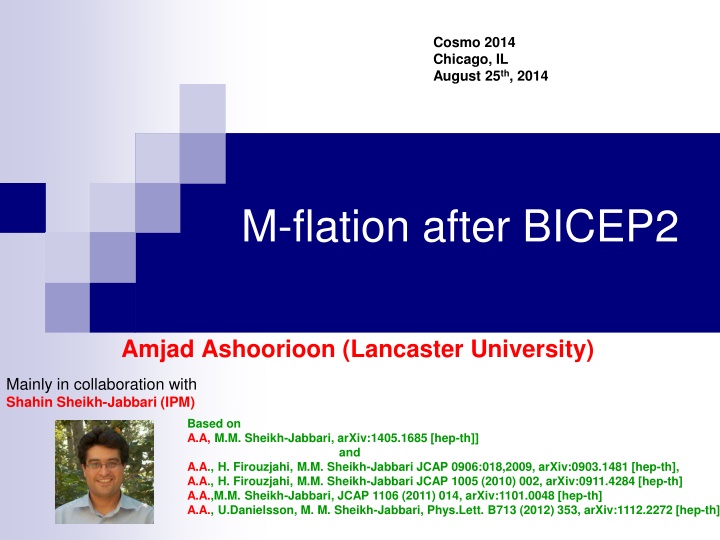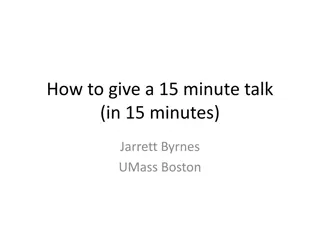
Exploring Large-Field Inflation Models in String Theory
Delve into the realm of cosmology with a focus on Large-Field Inflation Models in String Theory. Discover concepts such as Monodromy Inflation, N-flation, M-flation, and Multiple M5 brane Inflation, as well as the implications of precise CMB measurements from the Planck mission. Unravel the complexities of BICEP2's B-mode observations and the challenges they pose for theoretical model-building. Gain insights into axionic fields, moduli, and the dynamics of inflation in various string theory frameworks.
Download Presentation

Please find below an Image/Link to download the presentation.
The content on the website is provided AS IS for your information and personal use only. It may not be sold, licensed, or shared on other websites without obtaining consent from the author. If you encounter any issues during the download, it is possible that the publisher has removed the file from their server.
You are allowed to download the files provided on this website for personal or commercial use, subject to the condition that they are used lawfully. All files are the property of their respective owners.
The content on the website is provided AS IS for your information and personal use only. It may not be sold, licensed, or shared on other websites without obtaining consent from the author.
E N D
Presentation Transcript
Cosmo 2014 Chicago, IL August 25th, 2014 M-flation after BICEP2 Amjad Ashoorioon (Lancaster University) Mainly in collaboration with Shahin Sheikh-Jabbari (IPM) Based on A.A, M.M. Sheikh-Jabbari, arXiv:1405.1685 [hep-th]] and A.A., H. Firouzjahi, M.M. Sheikh-Jabbari JCAP 0906:018,2009, arXiv:0903.1481 [hep-th], A.A., H. Firouzjahi, M.M. Sheikh-Jabbari JCAP 1005 (2010) 002, arXiv:0911.4284 [hep-th] A.A.,M.M. Sheikh-Jabbari, JCAP 1106 (2011) 014, arXiv:1101.0048 [hep-th] A.A., U.Danielsson, M. M. Sheikh-Jabbari, Phys.Lett. B713 (2012) 353, arXiv:1112.2272 [hep-th]
Introduction The increasingly precise CMB measurements by Planck mission in combination with other cosmological date have ushered us into a precision early Universe cosmology era: ?? ?log?? ?log?+ 1 = 0.9603 0.0073 Planck 2013 ? 0.11;
Introduction BICEP2 surprise: claims that have observed the B-modes with at +0.07 ? = 0.2 0.05 80. Detection of ? 0.01 poses theoretical model-building challenges: o To embed such a model in supergravity, one has to insure the flatness of the theory on scales ? ??? 1/2 ? Lyth (1997) 1.06 0.01 o In stringy models, due to geometric origin of inflation in higher dimensions, ? ???. McAllister & Baumann (2007) From Planck experiment: ? 0.11 at ? = 0.002 ??? 1, 28 A priori these two experiments are not mutually-exclusive and can be reconciled A.A., K. Dimopoulos, M.M. Sheikh-Jabbari, G. Shiu, JCAP 1402 (2014) 025, arXiv:1306.4914 A.A., K. Dimopoulos, M.M. Sheikh-Jabbari, G. Shiu, arXiv:1403.6099 [hep-th]], to appear in PLB
Realization of Large-Field Models in String Theory Single-Field approach (aka Individualistic approach!): o An individual axionic field, whose potential is shift symmetric. in presence of fluxes spirals super-Planckian distances Monodromy Inflation Silverstein & Westphal (2008) McAllister, Silverstein, Westphal (2009) See Gary s and Eva s Talks Many Field approach (aka Socialistic approach!): o Many moduli, which could be axions or not, cooperate to cause inflation. o Even though the effective field excursion is larger than ???, individual field displacement is less! N-flation, Kachru et. al (2006) M-flation, Ashoorioon & Sheikh-Jabbari (2009) Multiple M5 brane Inflation, A. Krause, M. Becker, K, Becker (2005) A. Ashoorioon & A. Krause (2006)
Gauged M-flation N 3 2 ?4 ??3 123 = + k C x ij ijk 3 D PP-wave background , = j 6 dim to the D3-branes and K x denotes 3 spatial dim along and five transverse to the D3-branes. parameterize 3 out 3 , 2 , 1 i 10-d IIB supergravity background 3 8 = i = K + + = + 2 2 2 2 i 2 ( ) ( ) ds dx dx m x dx dx dx K K 1 1 ig 1 3 1 = + I J I J 4 ) 6 ( S d x g Q X X C F F s STr 1 | | , Myers (1999) ab 4 4 2 l g l 2 ( ) 4 IJ 0123 s s s = = M N , , = b a 5 , 4 , 0 ,..., 2, 1, 9 I J , 1 , 0 = g G X X , ..., 9 M N ab MN a b 3 i = + IJ IJ I J , Q X X 2 2 l s
Matrix Inflation from String Theory 4 m = the above background with constant dilaton is solution to the SUGRA 2 2 s g With 2 9 ) l 1 1 ig = + + 2 2 i ijk , , , s V X X X X X X X m X ( i j i j i j k 2 2 s 2 . 3 2 2 s 4 2 l X Upon the field redefinition i i j 3) 2 s 2 ( g l s 2 i m 8 = + + 2 i Tr , , , V i i j jkl k l j 4 3 2 = s g 2 m = 2 = 8 g g m . s s From the brane-theory perspective, it is necessary to choose m and such that 4 m = 2 2 sg 2 9 N D3-branes are blown up into a single giant D5-brane under the influence of RR 6-form. The inflaton corresponds to the radius of this two sphere.
Truncation to the SU(2) Sector: 2 are N X N matrices and therefore we have difficult scalars. It makes the analysis very 3N i However, one may show that there is a consistent classical truncation to a sector with single scalar field: ( = 3 , 2 , 1 = ) , t J i i i i J are N dim. irreducible representation of the SU(2) algebra: ijk j i i J J = , ( ) 1 ( ) N 12 J = 2 Tr J J N k i j ij Plugging these to the action, we have: = 2 ( Tr J Defining 2 1 2 M m ( ) ( ) 3 = i + + 4 2 4 3 2 Tr P S d x g R J 2 2 Tr Tr J i J 2 2 3 2 1 ) 2 / 1 to make the kinetic term canonical, the potential takes the form 2 2 2 2 m 8 N 2 N eff eff = + = = 4 3 2 ( ) , , V eff eff 0 ) 1 2 2 J N Tr ( 4 3 2 ) 1 2 2 J N Tr (
Analysis of the Gauged M-flation around the Single-Block Vacuum m 2 Hill-top or Symmetry-Breaking inflation, Linde (1992) Lyth & Boubekeur (2005) = 2 2 ( ) ( ) eff 4 V eff In the stringy picture, we have N D3-branes that are blown up into a giant D5-brane under the influence of RR 6-form. 1 (a) 5 4 10 N (c) (b) 10 6 M p
Mass Spectrum of Spectators (a) -modes 0 2 l l N ) 1 2 ( - 1 N Degeneracy of each l-mode is 2 + l 1 1 = + + + + 2 2 2 ( 2 )( ) 3 2 ( ) 2 M l l l m , eff eff l 2 (b) ) 1 + 1 2 l l N N ( 1 - -modes 1 l = Degeneracy of each l -mode is 2 + l 1 ) 1 + ) 1 + 2 2 2 ( 2 )( 2 ( M l l l m , eff eff 2 2 3 1 N (c) vector modes 2 ? Degeneracy of each l -mode is eff = ) 1 + 2 A 2 ( M l l 2 + l , l 1 4 = N 2 + ) 1 + ) 1 + N 2 2 2 N 5 1 ( 1 ( 1 3 1 N ?2 modes modes vector - field modes
Solving the model parameters based on Observables ???? ?(?) ? (?) 8? ? ?2 ?2+ 4? ?2+ 4? =1 ? ???? ? ? ???? ? 2??= (1) ??? 32ln ?? 2 ? ? (2) ? 1 2+ ??? 16??? 2+ 2?2 ? = 4??? = 1 2 2 144 + 8 1 ???2/??? 12 + ?? 1 = 2? 6? ? (3) 2= ?? 1 ?? ??? 2? 2 ? ? ??? Plugging (2) and (3) in (1) one can find solve ?/??? in terms of ?? numerically. ?(??) One can read off ???? 4?(??) 2.195 10 9 ??= 24?2???
(a) Symmetry-Breaking Region Right at the BICEP2 sweet spot For ??= 0.9603, and ??= 60 ? = 0.1991 0.2 From Planck experiment, within 2? 0.9457 ?? 0.9749 However not all this interval is covered by this branch of the model! ???????(??= 60) =58 if ? 0, ?????= ?? 61 0.9508 ?????????(??= 60) =117 if ? , ?????= ?? 121 0.9669 60 0.9749 0.9457 ?? 0.1322 ?60 0.2623 If ? ?? = 0.0029 as promised by CMBPOL ? [0.1983,0.2204]
(a) Symmetry-Breaking Region Spectra of the Isocurvature modes: o The lightest mode is ? = 0 gauge mode. For ??= 60 1.64 10 2(? 0) 8.27 10 3 (? ) = 1.24 10 2 For ??= 0.9603, ? = 0, is the massless mode ? 1 ? ? seed for dynamo mechanism that generates cosmic magnetic fields?!
Hilltop Regions (b) and (c) Due to symmetry ? ? ? at the level of background these two regions predict the same For ??= 0.9603, and ??= 60 ? = 0.0379 From Planck experiment, within 2? 0.9457 ?? 117 121 0.9669 (when ? ) 0.0155 ?60 0.1322 60 7.9948 10 14 25.43 ??? ?60 ???? If ? ?? = 0.0029 as promised by CMBPOL ? [0.0310,0.0475]
/ 2 0 / 2 Hilltop Regions (b) and (c) & Symmetry ? ? ? breaks down at the quantum level. In region (b), the lightest mode is ? = 0 gauge mode 8.27 10 3(? ) 9.83 10 4 In region (c), the lightest mode is ? = 1? mode 2.91 10 2(? ) 2.84 10 4 Around ? = 0, the isocurvature modes can act as preheat fields. The couplings of preheat fields to the inflaton are known. ?? 2 10 16at the peak frequency 1 ??? Which can be observed at Chongqin HFGW detector or Birmingham HFGW experiment.
Conclusions & Future Directions M-flation solves the fine-tunings associated with chaotic inflation couplings. It produces super-Planckian effective field excursions from many individual sub- Planckian ones which yield large tensor/scalar ratio compatible with Planck. M-flation which is qualitatively new third venue within string theory inflationary model-building. Matrix nature of the fields results in the production of isocurvature productions at the CMB scales. Due to hierarchical mass structure of the isocurvature modes, one can avoid the beyond-the-cutoff problem, exists in N-flation, even if = ??? ? A.A., M.M. Sheikh-Jabbari, JCAP 1106 (2011) 014, arXiv:1101.0048 [hep-th]
Conclusions & Future Directions The loop corrections from interactions of the graviton with the scalar field create the term 2 ?? naturally suppressed. A.A., U.Danielsson, M. M. Sheikh-Jabbari, Phys.Lett. B713 (2012) 353, arXiv:1112.2272 [hep-th] 2 ??2, if = ???. In M-flation and many field models such induced terms is M-flation has a natural built-in mechanism of preheating to end inflation around the ? = 0 vacuum which can produces large GHz frequency gravitational wave spectrum which could be seen by ultra-high frequency gravitational probes. Open Issue I: Reheating around the ? = ? Open Issue II: Building a full-fledged stringy setup with all moduli fixed. Works in progress
Thank you Thank you






















